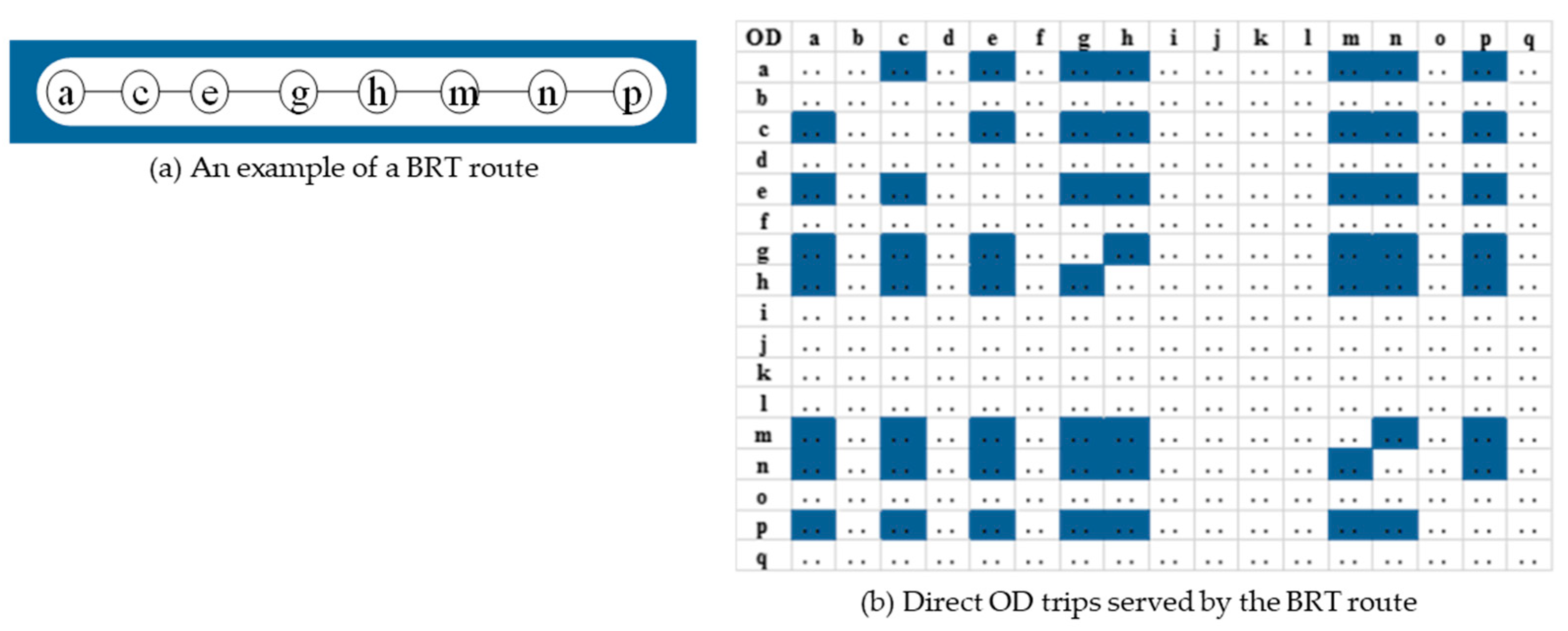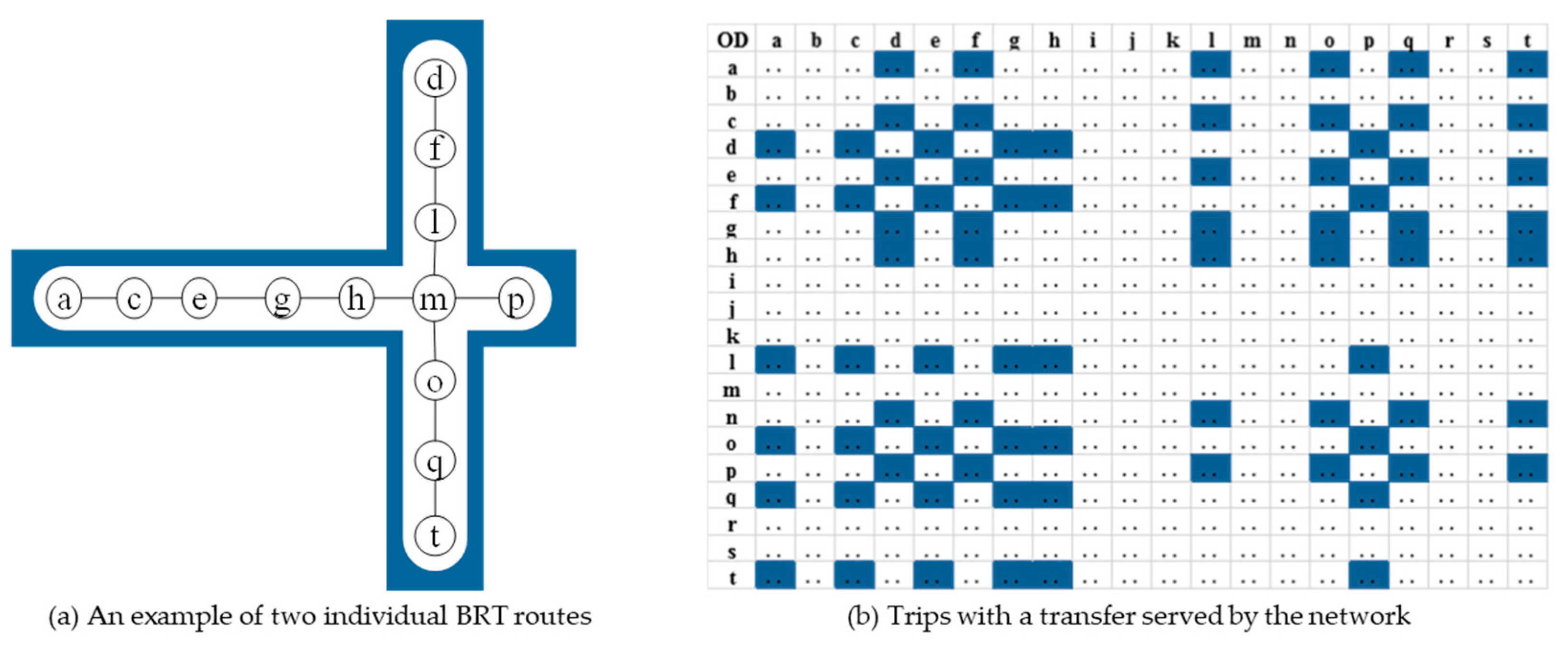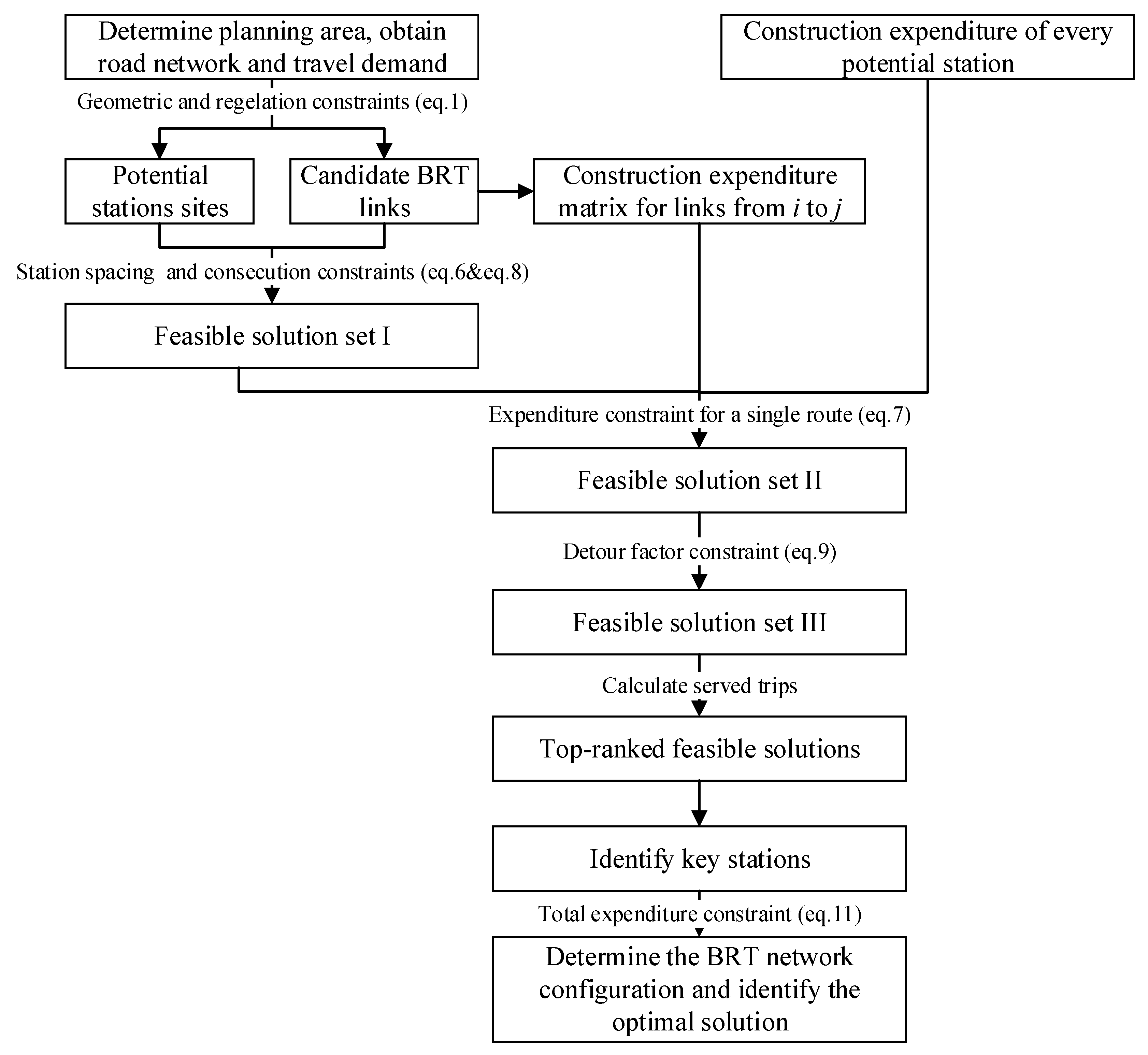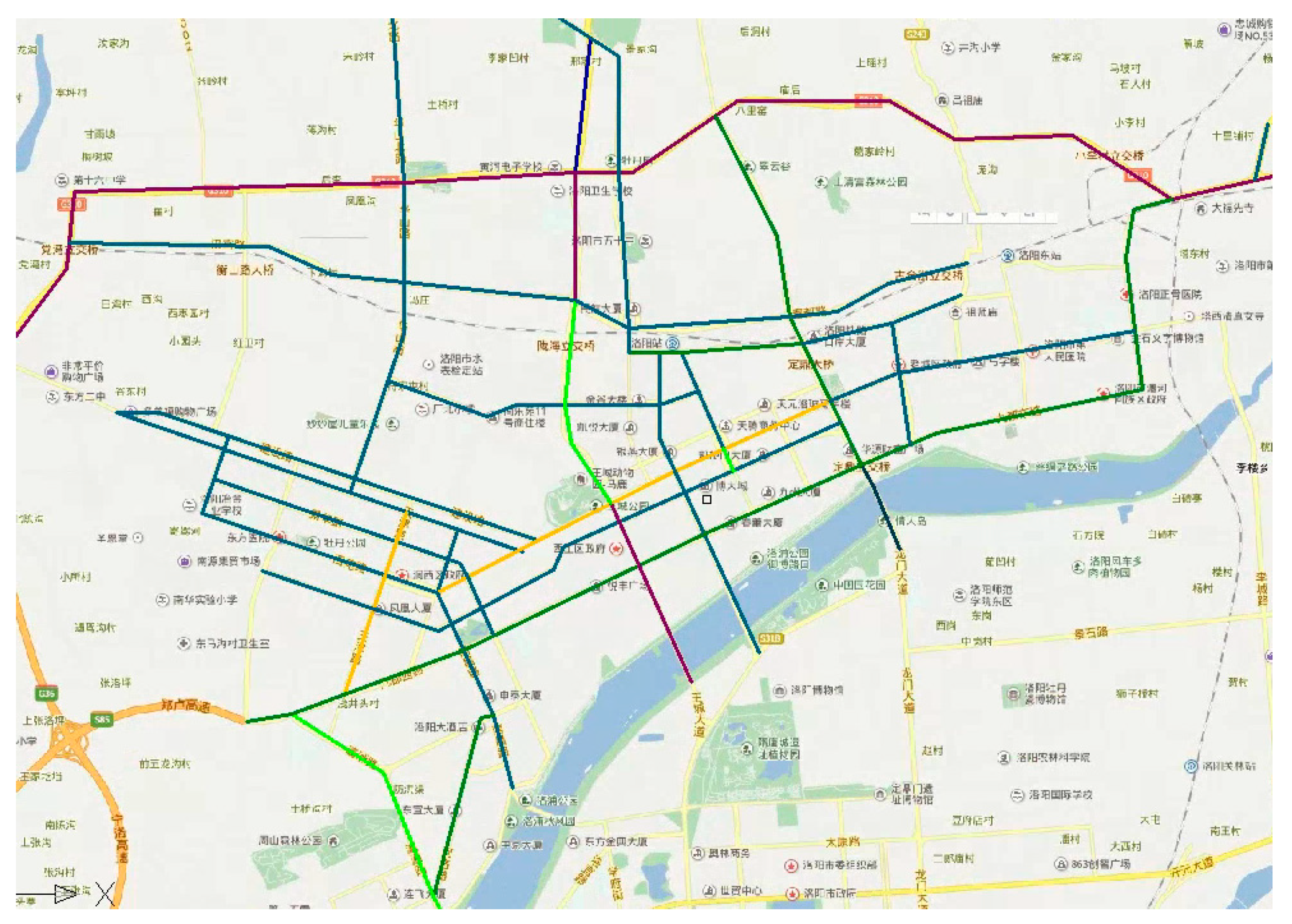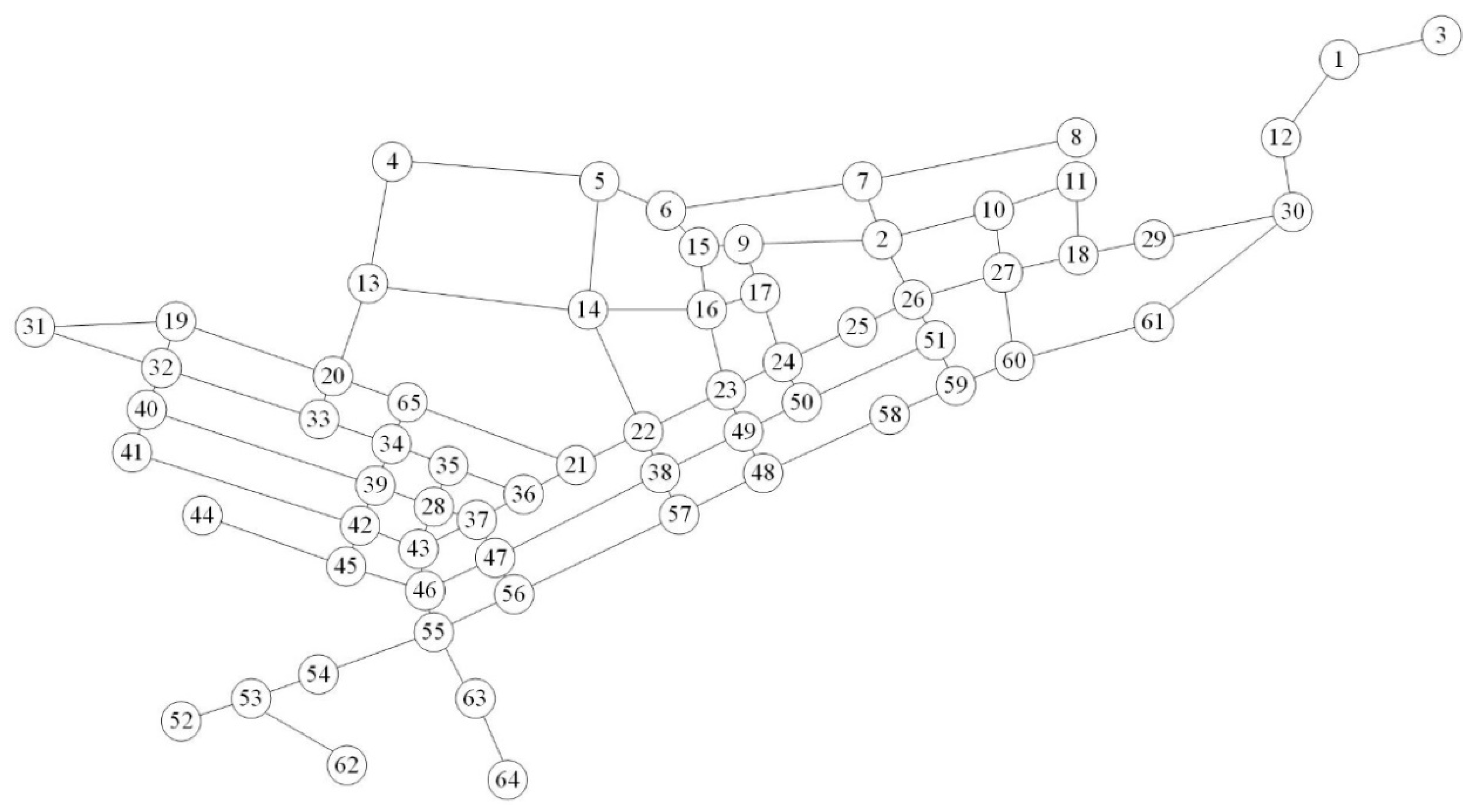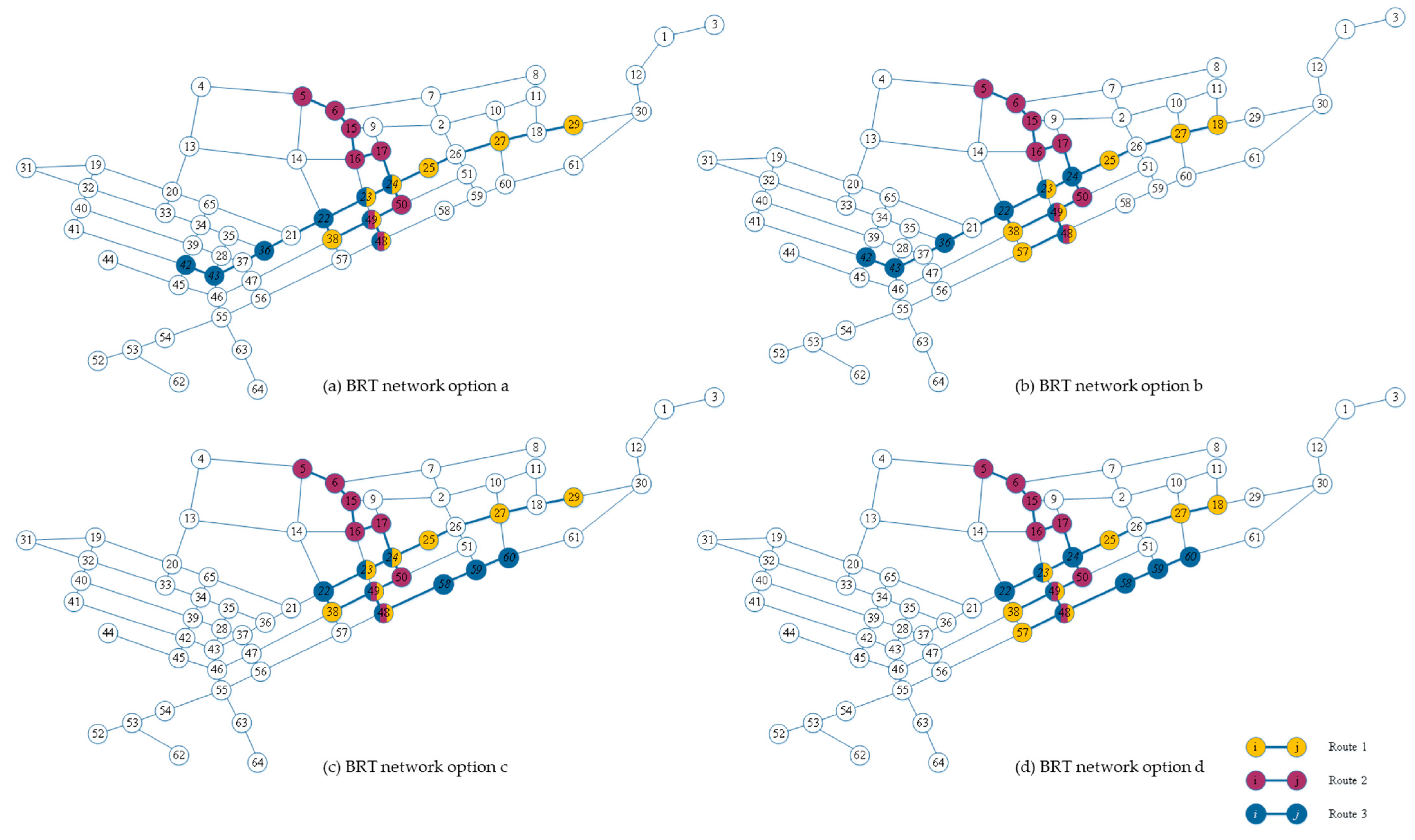1. Introduction
The rising private car ownership has caused remarkable travel demand increase, as well as traffic congestion, green gas emission, road accidents, and energy consumption. To address these problems, developing efficient and sustainable public transportation systems is extremely important. Various public transportation systems such as subway, light rail, conventional bus service, and BRT have been developed to compete with private cars. Among these public transportation systems, rail transit has the highest capacity and efficiency but needs large capital investment and a long implementation period. In addition, the rail transit allows railroad car operations only on fixed tracks and has a lack of service flexibility.
BRT, which can be defined as “a flexible, rubber-tired form of rapid transit that combines stations, vehicles, services, running ways and information technologies into an integrated system with strong identity” possesses the advantages of both conventional bus and rail transit in capacity and flexibility with relatively low cost and a quick implementation period [
1]. BRT is considered a system that can bridge the gap between the demand and supply of transportation. In the past decade, it has been embraced by a number of large and medium-sized cities in the world [
2,
3,
4,
5]. To ensure the success of its implementation and to make full use of the limited financial resource and road capacity, the BRT network and station locations must be carefully planned at the beginning.
Research studies on transit network design has continuously grown over time. Numerous researchers have conducted relevant literature reviews to summarize the previous studies on transit network design [
6,
7,
8,
9]. To be specific, Magnanti et al. reviewed some of the applications of integer programming methods for transit network design and introduced several continuous and discrete choice models and algorithms [
6]. Guihaire and Hao presented a global review of the design and scheduling of the transit network [
7]. Laporte et al. reviewed some indices for the quality of a rapid transit network as well as mathematical models and heuristics that can be used to solve the network design problem [
8]. Farahani et al. presented a comprehensive review of the definitions, classifications, objectives, constraints, network topology decision variables, and solution approaches for the public transportation network design problems [
9].
It has been widely recognized that operations research methods can help to determine the alignments and station sites of a transit network [
10]. Gutiérrez-Jarpa et al. proposed a tractable model in which travel cost was minimized and traffic capture maximized [
11]. The branch-and-bound method was used to solve the problem in the CPLEX framework. Besides, heuristic methods were often used to solve similar problems. Bruno et al. presented a mathematical model to maximize the total population covered by the rapid transit alignment, and a two-phase heuristic was used to generate a rapid transit alignment in an urban setting [
12]. However, the objective function in this study was only subjected to interstation spacing constraint, which was rather simplistic to reflect the reality. Nikolić and Teodorović developed a model to optimize the number of satisfied passengers, the total number of transfers, and the total travel time of all served passengers [
13]. The problem was solved using the Bee Colony Optimization (BCO) meta-heuristics. For the same problem in Nikolic and Teodorović’s study, Nayeem et al. developed a Genetic Algorithm (GA) to solve it [
14].
Recently, a majority of research studies have been conducted based on a heuristic method for transit network design problem. Wang et al. introduced a multi-level and multi-mode bus route network design method and proposed a hybrid heuristic approach. This innovative network design method involves various transit modes, which are associated with multiple network levels. For each network level, a corresponding optimization model was developed. Based on a case study of Zhaoyuan, China, the results revealed that the total travel time of the designed routes was decreased by 21.51% [
15]. According to the research conducted by Islam et al., an efficient heuristic method was presented to generate good solutions for the transit network design problem. It was found that this novel method outperformed other algorithms compared with previous research studies [
16]. In Owais and Osman’s research, GA as one of the Meta-heuristics was applied to the transit network design problem. The optimal Pareto front solutions were generated, and a novel frequency setting algorithm was introduced [
17]. To solve the multi-objective problems, GA was also used in the research study conducted by Bourbonnais et al. based on accurate local network data and public transit origin-destination data. Results revealed that this study can improve the efficiency by 10% to 20% [
18]. Ahmed et al. adopted selection hyper-heuristics for the transit network design to minimize the total travel time of passengers as well as the operational costs. It was found that this hyper-heuristic method outperformed other currently used solutions with faster run times [
19]. As for the bus rapid transit route design, Zhong et al. adopted an improved particle swarm optimization approach to determining the optimal BRT routes with the greatest number of served passengers. More advanced strategies were considered in the optimization [
20]. Zhang et al. utilized a hybrid metaheuristic approach by combining ant colony and genetic algorithms to solve the transit route network design problem especially for low-mobility individuals. [
21] Liu et al. applied an improved artificial fish swarm algorithm to solve the electric transit network design problem. The bus route design, service frequency, and the charging locations were optimized simultaneously. [
22]
In addition to the studies focusing on the model and the algorithm, some researchers have proposed methods to analyze and compare transit networks in the forms of a star, cartwheel, triangle, grid, and so on. Laporte et al. suggested that in grid cities, the modified grid and half-grid configurations were the best in terms of passenger-network effectiveness but inferior to grid configurations with respect to passenger-plane effectiveness [
10]. Hosapujari and Verma proposed an approach to develop a hub and spoke model for bus transit network services [
23].
Based on the research findings summarized above, it can be determined that the heuristic method is a prevalent and practical approach that has been applied for transit network design problem. However, few research studies have been conducted for BRT network design, which could be distinctive from the conventional public transit network design in terms of the unique features of BRT. Due to its relatively short history and limited implementations in developed countries, BRT has attracted little attention, which may lead to inadequate mathematical or theoretical supports for the BRT network design. In practice, the planning of BRT route or network often depends on planners’ experience instead of a scientific approach with solid quantitative analysis. Therefore, this research adopted the heuristic method considering the detour factor that might be neglected before aiming to put the BRT planning problem in a mathematical framework and determine the best solution. This systematical method can be applied in real world cases and can provide technical support for BRT planning. The remainder of this paper is structured as follows: In
Section 2, the BRT planning problem is introduced, and assumptions are described; in
Section 3, the mathematical model is established; in
Section 4, a heuristic method is proposed to solve the problem step by step;
Section 5 introduces an application to real case scenarios; finally, the summary and future studies are presented in
Section 6.
2. Problem Definition
2.1. The Right of Way for BRT
BRT differs from conventional public transportation modes in many aspects. It often requires dedicated right of way and special stations. Thus, it is a unique urban surface public transportation system. Some countries have planning guidelines and design standards for bus-only or BRT right of way settings. For example, according to “The setting for bus lanes (2004)” of China, bus-only lanes, including BRT lanes, should be set up when the street links meet all of the following conditions [
24]:
- (a)
The number of motor lanes in one direction should not be less than 3, or the total width of all motor lanes in one direction should not be less than 11 m;
- (b)
The number of bus passengers in one direction should not be less than 6000 during peak hours, or the bus volume should not be less than 150 per hour per direction during peak hours;
- (c)
The average traffic volume should be more than 500 vehicles per lane during peak hours.
BRT can be implemented on the roads that meet the above conditions. When developing the optimization model, these design standards or planning guidelines should be incorporated into the constraint set to reflect the regulation requirements, or we can first make a scan of the roads in the planning area and then search for feasible BRT routes on the candidate links. The scanning criteria can be expressed mathematically as follows:
where
i and
j denote the serial number of intersections in the planning area and
i ≠
j;
is the number of lanes from intersection
i to intersection
j;
is the bus volume on the link from intersection
i to intersection
j during peak hours;
is the average traffic volume on the lane from intersection
i to intersection
j during peak hours.
Equation (1) is the first constraint for the model, which is considered as geometric and regulation constraints. Only two-way roads are considered in this study, and the BRT route is assumed to be on a road link in both directions.
2.2. Trips Served by the BRT Network
In general, the OD matrices are established based on traffic analysis zone (TAZ) data such as land use, population, employment, etc. In this study, it is assumed that the ODs in the planning area are already known by modes of transportation and are presented in OD matrices. Since the centroids of TAZs, where trips start and end, are usually not station sites, the OD matrix based on TAZ centroids needs to be further converted into an OD matrix based on potential stations. To simplify the problem, the induced travel demand is not considered when a BRT network is constructed.
In the form of a piecewise function, an attraction function [
11] is introduced as
βki, which is dependent on the Euclidean metric distance
dki between the passenger location
k and the potential station
i. The attraction function is then assumed as follows:
Before calculating tij, which is the number of trips from station i to station j, it must be known whether βk1i and βk2j equal to 0. If both βk1i and βk2j are not 0, then (βk1i + βk2j) *(BODk1k2 + BODk2k1)/2 denotes of the trips from station i to station j, where BODk1k2 is bus OD trips from zone k1 to zone k2. If multiple stations are selected to serve the passengers from a TAZ, then the passenger trips will be proportionally allocated to these stations based on their distances to the centroid of TAZ.
In this study, it is assumed the amount of OD trips served by the BRT network contains two portions: direct trips and trips with a transfer. To simplify the problem, it is assumed that trips with more than one transfers are at a low level. Additionally, there are transfers between BRT and the conventional public transportation. To obtain this portion of transfer trips, the conventional public transportation network in the planning area must be known well. A significant amount of work needs to be done to address these issues, which will be considered in future studies.
Figure 1a gives a simple example of a BRT route and the blue cells in
Figure 1b represent the direct OD trips served by the route.
Figure 2a shows two individual BRT routes:
a-c-e-g-h-m-p and
d-f-l-m-o-q-t. Passengers will make transfers at station
m when necessary.
Figure 2b shows the trips with a transfer served by the network.
Then the total serving trips of the BRT network can be calculated through Equation (3):
where
tij is the amount of OD from
i to
j;
l’ and
l’’ are the sub-routes of BRT route
l;
is a 0–1 variable indicating whether
i and
j are on the same route
l and the trips from
i to
j are directly served trips, so are
and
;
is a dummy variable, when the distance between station
i and station
m is no more than the distance between station
i and station
j, then the value of
is equal to 1, otherwise 0.
2.3. The Potential Stations and Connections
To simplify the problem, it is assumed the BRT stations can be set near the intersection areas. All intersection areas that are on the qualified road links can be potential BRT station sites. The stations will then be automatically searched and selected for the BRT route according to the model established in the following sections.
Using geographic information data, the distance
ωij between each pair of adjacent intersections can be obtained. For those intersections that are not adjacent to each other, the distances are set to be infinite. Based on
ωij, the Floyd Algorithm is employed to calculate the distances between any two potential stations with the assumption of intersection-potential station overlap. The distance matrix and the shortest paths between each pair of potential stations are then generated. The procedure of the Floyd Algorithm is described as follows [
25]:
Step 0: Let k = 0, and every potential stations are given a serial number u1, u2, … un. Create a matrix D0, in which the elements is and a matrix P0, whose elements p0ij is i.
Step 1: k = k + 1, derive matrix Dk from matrix Dk−1, and derive matrix Pk from matrix Pk−1. For all ui and uj, and .
Step 2: If k = n, stop; else, go to Step 1.
3. The Mathematical Model
After a scan of qualified roads in the planning area according to Equation (1), we will further search BRT routes and stations to establish the BRT network. It is defined that xlij is whether the link from i to j is chosen by BRT route l: If the link from i to j is chosen, then xlij = 1; if the link from i to j is not chosen, then xlij = 0. yli indicates whether the potential station i is chosen by BRT route l: If a station is set at intersection i, then yli = 1; if a station is not set at intersection i, then yli = 0.
The objective of the model is to pursue the maximum number of trips served by the BRT network. As shown in Equation (3), the total number of trips served can be calculated as:
Thus, the mathematical model for this problem can be formulated as:
subject to:
where
ei is the construction expenditure of station
i;
Eij is the construction expenditure to implement BRT right of way on the link from
i to
j;
dmin and
dmax are the minimum and the maximum distances between two adjacent stations, respectively;
is a certain percentage of the total expenditure that varies for different case studies (
is assumed to be 40% in this research); C
N is a constant representing the threshold of detour factor.
Constraint (6) is the station spacing constraint that ensures the distance between any two adjacent stations falls into a certain range. Constraint (7) is the cost constraint that ensures the expenditure of a single BRT route is within the budget. Constraint (8) prevents a route from passing a station more than once and ensures the route is consecutive. Constraint (9) is the detour factor constraint that ensures the overall layout of the route maintains a certain level of straightness. The detour factor is the ratio of the route length and the Euclidean distance from the start point to the end point of a route. In some countries, regulations may require the detour factor of a bus route should be under a threshold value such as 1.4~1.6 [
26]. Constraint (10) is to match the OD pairs with the chosen stations. Constraint (11) is the total cost constraint that ensures the expenditure of the BRT network is within the budget.
4. The Process of the Heuristic Method
Based on the model established above, there will be two stages to solve the problem: (1) Obtain single route solutions, and (2) compose the routes into a network. The procedure of this heuristic can be found in
Figure 3.
Step 0: As described in
Section 2.3, the distance matrix and the paths between each pair of potential stations are calculated using the Floyd Algorithm.
Step 1: If a path goes from
i to
j via M links, then the
Eij can be calculated according to Equation (12). The expenditure matrix will then be established. The value of
cm, which represents the cost per unit length of right of way construction, can be determined according to lane number, length, width, etc.
Step 2: A new matrix with values in 1 or 0 is introduced, which indicates whether two stations can be selected consecutively on a route. The values of the matrix are determined by whether the distance dij of any two potential stations meets the station spacing constraint Equation (6).
Step 3: Starting from each potential station, a feasible solution set I is obtained, which contains the routes whose stations can be derived through the 0–1 matrix established in step 2. If a station has already been selected by a route, it will not be selected or passed through again. This ensures that BRT routes meet the route consecution constraint Equation (8).
Step 4: Examine the feasible routes generated from Step 3 with respect to cost constraint for each single route in Equation (7). The feasible solution set II is then obtained representing a set of routes, which meet station spacing, consecution, and cost constraints.
Step 5: Calculate each route’s length and the Euclidean distance between the start station and the end station, and then calculate each route’s detour factor. Eliminate the routes whose detour factors exceed the threshold, as shown in Equation (9), and obtain the feasible solution set III meeting all constraints.
Step 6: Calculate and rank the quantity of direct trips for each feasible route.
Step 7: Identify the key stations that frequently appear on the top-ranked feasible routes. Based on the rank of each feasible route in Step 6, a large number of top-ranked routes are selected for the key station identification. Stations with the highest frequency of appearance in the selected top-ranked feasible routes are identified to be the key stations.
Step 8: On the basis of key stations, compose the BRT network configuration by developing combinations of the top-ranked routes based on the total expenditure constraint in Equation (11). Calculate the trips with a transfer, then calculate T(i,j), and finally find the best combination as the optimal solution to the problem.
5. The Case Study and Numerical Results
To validate the model and algorithm proposed in this study, Luobei District in the City of Luoyang, China (seeing
Figure 4) was chosen for a case study. The road network and travel demand data were obtained from local planning agencies. The data of population, traffic analysis zones, and the transport network used in this study came from an established travel demand forecast model, which was last updated in 2014.
The City of Luoyang, located in the west of Henan Province, is the vice center of Henan Province with a population of 6.92 million. Luoyang has a total area of 15,209 km
2, accounting for 9% of the total area of Henan Province, of which the urban area is 544 km
2. The annual GDP of Luoyang in 2013 was 314.08 billion yuan, which was increased by 7.2% compared to the previous year [
27]. The car ownership in Luoyang by the end of 2013 was 933,110, which was growing rapidly for the last few years [
28].
The travel modes of Luoyang include private car, bus, walking, biking, taxi, and others. The mode share of public transportation is not high, with a percentage of approximately 20%. However, there is a large demand for public transportation in Luoyang, and the road capacity is insufficient. Therefore, corresponding measures should be taken to promote the development of public transportation, which will help to solve the current traffic congestion problem in Luoyang.
First, the geometric and regulation constraints are employed to identify the candidate links where BRT right of way can be implemented. Intersections on the candidate links are then numbered as the potential station sites, see
Figure 5. As shown in the figure, the road network contains 96 links and 65 intersections.
In the case study, it is assumed lmin = 550 m, lmax = 1800 m, and CN = 1.6. Emax are assumed to be a certain budget value according to the number of stations and the total length of a BRT route. The average construction expenditure of a station is assumed to be 1 million CNY, and 30 million CNY for 1 km of BRT right-of-way.
Following the steps described in
Section 4, more than 100,000 feasible solutions are found until Step 6. In Step 7, station 38, 48, and 49 are identified as the key stations because they are the most frequently selected ones among the top-ranked feasible solution set. As pointed out by Laporte et al. [
10], there are several basic configurations for a transit network including star, cartwheel, triangle, grid, and modified configurations. Based on the recommendations and distribution of the key stations, the modified grid configuration is selected for the case study area in order to achieve the best results in terms of passenger-network effectiveness.
Table 1 and
Table 2 depict the detailed information of the network solution and routes included. Four network options, from
a through
d, are presented, each having three BRT routes. As shown in
Table 1, each route will serve 31,758–35,537 trips directly with lengths varying from 2308 to 3095 m. The transfer trips are added and shown in
Table 2. The expenditure of each route is provided in
Table 1 while the total expenditure of each network option is given in
Table 2, which indicates that the budget constraint
Emax is effective. The detour factors are set to be under the constraint of 1.6. From
Figure 6, one can see the alignment of the selected route zigzags in the planning area with the detour factor value ranging from 1.49 to 1.58. To improve this, the threshold value of the detour factor constraint can be set lower according to the size of the planning area and the number of stations on the BRT route.
From
Table 2, it can be seen that Option c is better than others in all aspects including the objective function value, the directly served trips, served trips with transfers, total length, and network expenditures. It is then considered the best solution for the case study area with respect to all the constraints. This BRT network option, containing three routes, will serve a total of 151,482 direct and one-transfer BRT trips per day in the case study area. It proves that the proposed method is capable of finding the BRT network that will serve the maximum number of OD trips while satisfying the constraints of budget, detour factor, station spacing, and road geometrics.
To conclude, the optimal solution is obtained based on the algorithm results and the configurations of the BRT network. Option c is selected to be the best BRT network design in Luoyang with the shortest length of the BRT routes and greatest served trips among all the candidate options. One inherent reason that can be implied is that the optimal BRT network option tends to cover the key stations by serving more trips and sustains the total length of the BRT routes to be as short as possible to reduce the expenditure. Since the characteristics of the city of Luoyang reveal that the region of the majority of trip generations are located in certain typical areas, option c outperforms other options by selecting the stations that serve a larger number of trips within a certain area.
6. Conclusions and Outlook
Considering factors such as distance between stations, expense of construction, road geometrics, and so on, the authors proposed a mathematical model for the BRT network planning problem, followed by a heuristic algorithm and a case study in Luoyang, China.
The objective function of the model is to maximize the total trips served by a BRT network, subject to a number of geometric, regulation, station spacing, expenditure, and consecution constraints. In addition, a detour factor is introduced in the mathematical model to measure the straightness of the BRT route alignment. A heuristic method is applied to solve the problem and to generate a BRT network solution. Although the algorithm has relatively low efficiency, it is effective to find the optimal solution of a BRT network including routes and stations, and it is easy to understand and implement.
This study makes a contribution to improve the scientific and quantitative analysis in BRT planning. Since the planning practice is often influenced by politics and the subjectivity of decision makers, the quantitative results from applying this method can be presented as decision support materials. The limitation of this research is that the served trips calculated in this research only contain the directly served OD and OD with one transfer, therefore whether and how to include the multiple transfers needs to be carefully examined in the future. Regarding future research directions, it is possible to improve the algorithm efficiency in the future. This research effort can be further extended to investigate the most efficient network configuration regarding the star, cartwheel, triangle, grid, and modified configurations. Furthermore, trips with multiple transfers and the transfer trips between BRT and the conventional public transportation system can also be included in the calculation to ensure it is closer to the real situation.
Author Contributions
Conceptualization, Z.W., F.L., Z.L., and L.L.; methodology, Z.W., F.L., and Z.L.; software, Z.W., F.L., and Z.L.; validation, Z.W., F.L., and Z.L.; formal analysis, Z.W., F.L., Z.L., and L.L.; investigation, Z.W., F.L., and Z.L.; resources, Z.W.; data curation, Z.W.; writing—original draft preparation, Z.W., F.L., and Z.L.; writing—review and editing, Z.L. and L.L.; visualization, Z.W., F.L., and Z.L.; supervision, Z.W., Z.L., and L.L.; project administration, Z.W.; funding acquisition, Z.W. All authors have read and agreed to the published version of the manuscript.
Funding
This research was funded by the Global Environmental Facility (GEF), grant number LY-BRT1.
Institutional Review Board Statement
Not applicable.
Informed Consent Statement
Not applicable.
Data Availability Statement
The data are held with the authors.
Acknowledgments
We would like to thank Luoyang Public Transport Company for their great effort in supporting this research.
Conflicts of Interest
The authors declare no conflict of interest.
References
- Levinson, H.; Zimmerman, S.; Clinger, J.; Gast, J.; Rutherford, S.; Bruhn, E. Implementation Guidelines, Transit Cooperative Research Program—Report 90. In Bus Rapid Transit; Transportation Research Board: Washington, DC, USA; National Academies: Washington, DC, USA, 2003; Volume 2. [Google Scholar]
- Global BRT Data. Produced by Bus Rapid Transit across Latitudes and Cultures and EMBARQ, in Partnership with IEA and SIBRT. Available online: http://brtdata.org (accessed on 5 June 2016).
- Hidalgo, D. Bus Rapid Transit, Worldwide History of Development, Key Systems, and Policy Issues. In Transportation Technologies for Sustainability; Springer: New York, NY, USA, 2013; pp. 235–255. [Google Scholar]
- Lindau, L.A.; Hidalgo, D.; de Almeida Lobo, A. Barriers to planning and implementing Bus Rapid Transit systems. Res. Transp. Econ. 2014, 48, 9–15. [Google Scholar] [CrossRef]
- Hassan, S.A.; Hamzani, I.N.S.; Sabli, A.R.; Sukor, N.S.A. Bus Rapid Transit System Introduction in Johor Bahru: A Simulation-Based Assessment. Sustainability 2021, 13, 4437. [Google Scholar] [CrossRef]
- Magnanti, T.L.; Wong, R.T. Network Design and Transportation Planning: Models and Algorithms. Transp. Sci. 1984, 18, 1–55. [Google Scholar] [CrossRef]
- Guihaire, V.; Hao, J. Transit Network Design and Scheduling: A Global Review. Transp. Res. Part A Policy Pract. 2008, 42, 1251–1273. [Google Scholar] [CrossRef]
- Laporte, G.; Mesa, J.A.; Ortega, F.A.; Perea, F. Planning Rapid Transit Networks. Socio Econ. Plan. Sci. 2011, 45, 95–104. [Google Scholar] [CrossRef]
- Farahani, R.Z.; Miandoabchi, E.; Szeto, W.Y.; Rashidi, H. A Review of Urban Transportation Network Design Problems. Eur. J. Oper. Res. 2013, 229, 281–302. [Google Scholar] [CrossRef]
- Laporte, G.; Mesa, J.A.; Ortega, F.A. Optimization Methods for the Planning of Rapid Transit Systems. Eur. J. Oper. Res. 2000, 122, 1–10. [Google Scholar] [CrossRef]
- Gutiérrez-Jarpa, G.; Obreque, C.; Laporte, G.; Marianov, V. Rapid Transit Network Design for Optimal Cost and Origin-Destination Demand Capture. Comput. Oper. Res. 2013, 40, 3000–3009. [Google Scholar] [CrossRef]
- Bruno, G.; Gendreau, M.; Laporte, G. A Heuristic for the Location of a Rapid Transit Line. Comput. Oper. Res. 2002, 29, 1–12. [Google Scholar] [CrossRef]
- Nikolić, M.; Teodorović, D. Transit Network Design by Bee Colony Optimization. Expert Syst. Appl. 2013, 4, 5945–5955. [Google Scholar] [CrossRef]
- Nayeem, M.A.; Rahman, M.K.; Rahman, M.S. Transit network design by genetic algorithm with elitism. Transp. Res. Part C Emerg. Technol. 2013, 46, 30–45. [Google Scholar] [CrossRef]
- Wang, C.; Ye, Z.; Wang, W. A multi-objective optimization and hybrid heuristic approach for urban bus route network design. IEEE Access 2020, 8, 12154–12167. [Google Scholar] [CrossRef]
- Islam, K.A.; Moosa, I.M.; Mobin, J.; Nayeem, M.A.; Rahman, M.S. A heuristic aided Stochastic Beam Search algorithm for solving the transit network design problem. Swarm Evol. Comput. 2019, 46, 154–170. [Google Scholar] [CrossRef]
- Owais, M.; Osman, M.K. Complete hierarchical multi-objective Genetic Algorithm for transit network design problem. Expert Syst. Appl. 2018, 114, 143–154. [Google Scholar] [CrossRef]
- Bourbonnais, P.L.; Morency, C.; Trépanier, M.; Martel-Poliquin, E. Transit network design using a genetic algorithm with integrated road network and disaggregated O-D demand data. Transportation 2019, 48, 95–130. [Google Scholar] [CrossRef]
- Ahmed, L.; Mumford, C.; Kheiri, A. Solving urban transit route design problem using selection hyper-heuristics. Eur. J. Oper. Res. 2019, 274, 545–559. [Google Scholar] [CrossRef]
- Zhong, S.; Zhou, L.; Ma, S.; Jia, N.; Zhang, L.; Yao, B. The optimization of bus rapid transit route based on an improved particle swarm optimization. Transp. Lett. 2018, 10, 257–268. [Google Scholar] [CrossRef]
- Zhang, T.; Ren, G.; Yang, Y. Transit route network design for low-mobility individuals using a hybrid metaheuristic approach. J. Adv. Transp. 2020, 2020, 1–12. [Google Scholar] [CrossRef]
- Liu, Y.; Feng, X.; Ding, C.; Hua, W.; Ruan, Z. Electric transit network design by an improved artificial fish-swarm algorithm. J. Transp. Eng. Part A Syst. 2020, 146, 04020071. [Google Scholar] [CrossRef]
- Hosapujari, A.B.; Verma, A. Development of a Hub and Spoke Model for Bus Transit Route Network Design. Procedia Soc. Behav. Sci. 2013, 104, 835–844. [Google Scholar] [CrossRef]
- Chinese Ministry of Public Security. The Setting for Bus Lanes; Ministry of Public Security: Beijing, China, 2004.
- Lu, H. Theory and Method in Transportation Planning, 2nd ed.; Tsinghua University Press: Beijing, China, 2006. [Google Scholar]
- The Ministry of Construction of the People’s Republic of China. Code for Transport Planning on Urban Road; State Bureau of Technical Supervision; The Ministry of Construction of China: Beijing, China, 1995.
- The People’s Government of Luoyang Municipality. Statistical Bulletin of National Economic and Social Development of Luoyang in 2013. Available online: http://www.ly.gov.cn/html/1/2/10/29/35/504559.html (accessed on 17 May 2021).
- The People’s Government of Luoyang Municipality. More than 0.23 Million People in Luoyang Received drivers’ Licenses and Nearly 0.1 Million New Cars Were Increased. Available online: http://www.ly.gov.cn/html/1/2/4/5/707432.html (accessed on 17 May 2021).
| Publisher’s Note: MDPI stays neutral with regard to jurisdictional claims in published maps and institutional affiliations. |
© 2021 by the authors. Licensee MDPI, Basel, Switzerland. This article is an open access article distributed under the terms and conditions of the Creative Commons Attribution (CC BY) license (https://creativecommons.org/licenses/by/4.0/).
